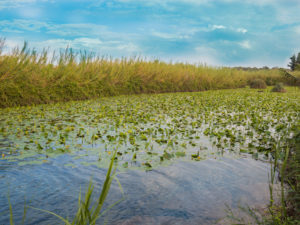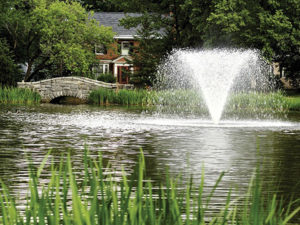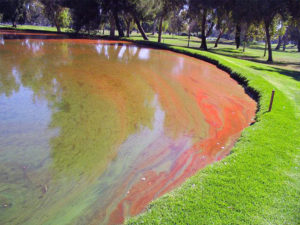The trophic state of a water body is a relative expression of the biological productivity of the pond or lake. The condition or health of a body of water is determined by many factors. The physical attributes of a pond, such as size, depth and soil type all influence water quality.
Another main contributing factor that affects water quality is the watershed that supplies a water body. The size of the watershed and practices occurring within the watershed have a great impact on surface run-off.
Construction and disturbance of soil can hasten the process of sedimentation, while farming can increase nutrient loading. As water bodies age, they will ultimately accumulate sediment, silt and organic matter. This natural process of aging and nutrient enrichment is known as eutrophication.
Measuring the Conditions of a Pond or Lake
Many parameters are measured to determine the condition of a lake or pond, including:
- pH
- alkalinity
- hardness
- conductivity
- secchi depth
- temperature/dissolved oxygen profile
- chlorophyll a
- zooplankton
- phytoplankton and total phosphorus
A select few analyses can be done to determine the general condition of your water body or a more in-depth analysis may be carried out to give a better assessment of the trophic state of your water body.
What is Trophic State Index?
The Trophic State Index (TSI), developed by R.E. Carlson, is among the most commonly used indicators of a pond or lake’s trophic state. These index values are actually composed of three separate indices based on concentrations of total phosphorus, chlorophyll a and the Secchi depth readings from a variety of lakes.
Mean values of total phosphorus, chlorophyll a, and Secchi depth for an individual water body are converted to a scale of relative trophic state ranging from 1 to 100. A TSI of less than 35 indicates oligotrophic (low nutrient, high oxygen) conditions. A TSI between 35 and 50 indicates mesotrophic (a significant and slightly worrisome conditions and a TSI greater than 50 indicates eutrophic conditions.
Types of Tropic State Indexes for Ponds and Lakes
Oligotrophic
Oligotrophic comes from the Greek meaning “poorly nourished” and describes water that has low plant growth productivity and high transparency. Oligotrophic waters are clear with few aquatic plants or algae growing in them.
Mesotrophic
Mesotrophic comes from the Greek meaning “moderately nourished” and describes a lake of moderate photosynthetic activity and transparency. These ponds and lakes are in the middle of the plant and algae growth spectrum.
Eutrophic

Water Lily Pool of Yarkon National Park – pond full of yellow water lilies (Nuphar lutea)
Eutrophic comes from the Greek meaning “well-nourished” and describes a lake of high photosynthetic activity and low transparency. These water bodies are more turbid and have an abundance of aquatic plant and algae cultivation .
Hypereutrophic
Hypereutrophic, or excessively productive lakes, have TSI values greater than 70. The higher the TSI value, the greater the probability of encountering nuisance levels of plant and algae growth.
Importance of Collecting TSI Values
By collecting the data needed to calculate the TSI values for a water body, you obtain an improved understanding of the water quality and how it compares to other water bodies. We have been able to use TSI parameters to compare one lake to another or even compare one month to another in a given season. This gives us the ability to better develop or alter a management plan for a given water body.
Find Out Your Pond’s Trophic State with AEC
Get your pond or lake tested today with AEC lakes. We can measure the conditions of your pond or lake to help you figure out the trophic state and much more to craft the right management plan. Contact our team today for more information.





Add Comment